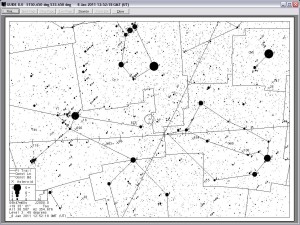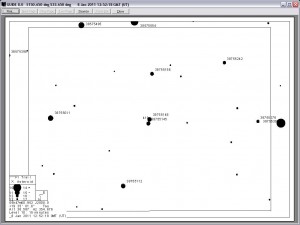If you have a medium sized amateur telescope, Saturday evening you might like to set it up and watch as a star appears to ‘blink’. Stars don’ really blink so there has to be another reason why a star might suddenly disappear from view and reappear a short time later. What is really happening is called an asteroidal occultation. These occur quite frequently when one of the many tens of thousands of asteroids (large chunks of rock drifting in space in their own orbits around the Sun) happen to pass in front of a star. The light from the star is momentarily blocked from view causing what is called a asteroidal occultation.
There is a catch with asteroidal occultations (apart from usually needing a telescope) and that is that asteroids are quite small. This means that you need to be located on a fairly narrow band of the Earth’s surface to see the occultation (which you could also think of as being a shadow cast by the asteroid onto the Earth’s surface). The asteroid doing the occulting Saturday night is 419 Aurelia and is fairly large at 137 km in diameter. This means that where you can be on the Earth’s surface is somewhat wider than usual. Assuming you have clear skies, the occultation will be visible from Auckland in New Zealand and Adelaide, Sydney, Newcastle, Wollongong, Bathurst and Mudgee in Australia. A combined finder chart and chart showing where you can be to see the occultation can be found here on Steve Preston’s Asteroid Occultation website.

The next thing of course is when and where to point your telescope Saturday night. The ‘where’ is easy thanks to Dave Gee to has provided a couple of finder charts he generated using the Guide 8 astronomy computer program. The first (above) is a wide angle chart showing you where to start looking (below Orion ‘The Hunter’).

I suggest you practice finding the star before Saturday night. It is only 11.2 magnitude. This is much fainter than the unaided eye can see and (if you are like me) you will need practice to find it. The ‘when’ is a bit more uncertain. According to the information on the Asteroid Occultation website, the occultation can happen anytime between 10.48 pm AEST and 10.57pm AEST (add one hour if your location is following ‘Summer time’) and last 9.7 seconds at most.
UPDATE (8 January 2010): Thanks to John Broughton for the more exact occultation times. Note that the local time listed is in ‘Summer time’. Don’t add an hour or you will miss the event. The local daylight saving time is in brackets and in red. The uncertainty is only a few seconds, occurring near these times in the three major cities within the path.
Auckland 12:50:00 UT (1:50:00 am local time (Summer time))
Sydney 12:52:15 UT (11:52:15 pm local time (Summer time))
Adelaide 12:53:40 UT (11:23:40 pm local time (Summer time))
And now for the coolest thing about watching this occultation! By recording the duration of the disappearance, you can calculate exactly how big the asteroid is, or even if it has its own satellites! Dave Gee (who provided me with the finder charts) has kindly outlined how you can do this.
(Text from his email) Visual observers would need a 6″ or larger telescope to detect the mag. 11.2 target star, UCAC2 38755148. Video observers with telescopes 10″ or larger could use the KT&C-350 video camera, however 11.2 is at the limit of an 8″ scope, so an integrating camera would be needed running stacks of 4 frames or so. Finder charts can be found at… http://www.asteroidoccultation.com/2011_01/0108_419_23398.htm Ideally, you will need a good access to Universal Time (UT) – GPS with 1PPS, Beeper Box synchronised with BeeperSync or shortwave radio tuned to WWVH, however, for those lacking a good UT timebase, simply report the event duration to the best of your ability, the approximate event times based on NTP time servers or a GPS, and finally, your geographic coordinates.
In the hour before the event, observers with telescopes larger than 12″ might see the mag. 13.3 asteroid appulse the star and about 10 minutes before the event the two objects will merge and the pair will brighten very slightly. For observers with smaller telescopes (8″ or less) the star will disappear completely for a maximum of 9.7 seconds. However, observers with telescopes larger than 12″ will see the star will disappear, leaving the asteroid in view for the event period. Of course all this depends on the clarity of the atmosphere, the sensitivity of the observer’s eye, the quality of the telescope, ect ect.
I have never had the pleasure of seeing an asteroid occultation, and I will miss this one because of my location. I hope you have clear skies for this event. For more information, I suggest you subscribe to the rasnzoccultations@yahoogroups.com group. Steve Preston has very useful information on his website about observing asteroid occultations.
Hi Paul,
Here is an asteroid occultation video on youtube…
http://www.youtube.com/watch?v=LTppV1JfXAE
has sound.
thanks and regards
Dave
Dave,
Thank you for the Youtube link.
Regards,
Paul Floyd.
In case any one who has not observed an Occultaion before manages and wants to report their result. Please down load a form from http://occsec.wellington.net.nz/report.htm and send it to me at mailto:john.talbot@xtra.co.nz
All positve events are published on the RASNZ Occsec site http://occsec.wellington.net.nz/
Regards
John Talbot
Thanks for that.
Paul Floyd.